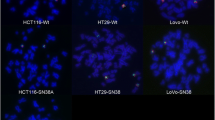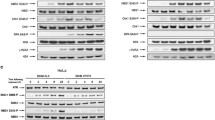Abstract
Purpose: Methyl N-(4′-(9-acridinylamino)-phenyl)carbamate hydrochloride (AMCA) and methyl N-(4′-(9-acridinylamino)-2-methoxyphenyl)carbamate hydrochloride (mAMCA) are analogues of the topoisomerase II (topo II) poison amsacrine, and are distinguished from amsacrine by their high cytotoxicity towards non-cycling cells. Since mammalian cells contain two forms (α and β) of topo II and the α isoform is down-regulated in non-cycling cells, we have considered whether these carbamate analogues target topo IIβ selectively. Methods: A drug permeable yeast strain (JN394 top2-4) was transformed using a shuttle vector containing either human top2α, human top2α or yeast top2 under the control of a GAL1 promoter. The strain was analysed at a non-permissive temperature, where only the plasmid-borne topo II was active. Results: AMCA and mAMCA produced comparable levels of cell killing with human DNA topo IIα, human DNA topo IIβ and yeast DNA topo II. Two other acridine derivatives N-[2-(dimethylamino)ethyl]acridine-4-carboxamide (DACA) and its 7-chloro derivative, which like AMCA and mAMCA are able to overcome multidrug resistance mechanisms, were much more active against human DNA topo IIα than against human DNA topo IIβ and yeast DNA topo II. A series of mutant Chinese hamster and human lines with defined topo lesions, including the HL60/MX2 line that lacks topo IIβ expression, was also used to compare resistance to amsacrine, AMCA and etoposide. Loss of topo IIβ activity had a greater effect on amsacrine and AMCA than on etoposide. Resistance of murine Lewis lung cultures in exponential and plateau phase was also measured. Loss of topo IIα activity, as measured in both mutant cells expressing lower amounts of enzyme and in cells in plateau phase, resulted in concomitant acquisition of resistance that was greatest for etoposide and least for AMCA. Conclusion: We conclude that the carbamate analogues of amsacrine recognize both topo IIα and β in cells.
Similar content being viewed by others
Author information
Authors and Affiliations
Additional information
Received: 7 September 1998 / Accepted: 29 January 1999
Rights and permissions
About this article
Cite this article
Turnbull, R., Meczes, E., Perenna Rogers, M. et al. Carbamate analogues of amsacrine active against non-cycling cells: relative activity against topoisomerases IIα and β. Cancer Chemother Pharmacol 44, 275–282 (1999). https://doi.org/10.1007/s002800050978
Issue Date:
DOI: https://doi.org/10.1007/s002800050978




